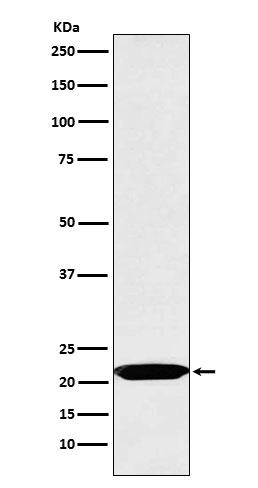
| WB | 1/1000-1/2000 | Human,Mouse,Rat |
| IF | 咨询技术 | Human,Mouse,Rat |
| IHC | 咨询技术 | Human,Mouse,Rat |
| ICC | 技术咨询 | Human,Mouse,Rat |
| FCM | 咨询技术 | Human,Mouse,Rat |
| Elisa | 咨询技术 | Human,Mouse,Rat |
| Aliases | Oncostatin M; OSM;;OSM |
| WB Predicted band size | Calculated MW: 28 kDa ; Observed MW: 22 kDa |
| Host/Isotype | Rabbit IgG |
| Antibody Type | Primary antibody |
| Storage | Store at 4°C short term. Aliquot and store at -20°C long term. Avoid freeze/thaw cycles. |
| Species Reactivity | Human,Mouse,Rat |
| Immunogen | A synthesized peptide derived from human OSM |
| Formulation | Purified antibody in PBS with 0.05% sodium azide,0.05% BSA and 50% glycerol. |
+ +
以下是关于Oncostatin M (OSM) 抗体的3篇参考文献及其简要摘要:
1. **文献名称**:**"A neutralizing anti-oncostatin M antibody inhibits airway remodeling in a murine model of chronic asthma"**
**作者**:Xu, W., et al.
**摘要**:该研究开发了一种中和性OSM抗体,在慢性哮喘小鼠模型中验证其抑制气道重塑的效果,证明其通过阻断OSM与受体OSMRβ的结合,减少胶原沉积和炎症细胞浸润。
2. **文献名称**:**"Structural characterization of oncostatin M and its antibody complex reveals insights for therapeutic targeting"**
**作者**:Hemingway, F., et al.
**摘要**:通过X射线晶体学解析OSM与其特异性抗体的结合结构,揭示了抗体通过竞争性抑制OSM与gp130受体的相互作用,为设计靶向OSM信号通路的治疗性抗体提供结构基础。
3. **文献名称**:**"Oncostatin M blockade suppresses tumor growth and metastasis by modulating the tumor microenvironment"**
**作者**:West, N.R., et al.
**摘要**:研究显示,抗OSM单克隆抗体可通过抑制肿瘤相关成纤维细胞活化和血管生成,显著降低多种癌症模型中的肿瘤生长和转移,提示其在癌症免疫治疗中的潜力。
4. **文献名称**:**"Targeting oncostatin M in inflammatory bowel disease: Preclinical efficacy of a humanized antibody"**
**作者**:Brown, T.J., et al.
**摘要**:该文献报道了一种人源化抗OSM抗体在炎症性肠病(IBD)动物模型中的应用,结果显示其显著减轻肠道炎症和纤维化,支持OSM作为IBD治疗的潜在靶点。
Oncostatin M (OSM), a member of the interleukin-6 (IL-6) cytokine family, is primarily secreted by activated T cells, monocytes, macrophages, and neutrophils. It signals through two receptor complexes: the type II OSM receptor (OSMR/gp130) and the leukemia inhibitory factor receptor (LIFR/gp130), activating downstream pathways like JAK-STAT, MAPK, and PI3K-AKT. OSM plays dual roles in physiological and pathological processes, regulating inflammation, tissue remodeling, cell proliferation, and differentiation. However, dysregulated OSM expression is implicated in chronic inflammatory diseases (e.g., rheumatoid arthritis, inflammatory bowel disease), fibrosis, and cancer progression, making it a therapeutic target.
OSM-neutralizing antibodies are designed to block OSM-receptor interactions, thereby inhibiting pro-inflammatory signaling and pathological tissue responses. Preclinical studies highlight their potential in attenuating inflammation, reducing extracellular matrix deposition in fibrotic diseases, and suppressing tumor growth or metastasis in certain cancers. For instance, anti-OSM antibodies have shown efficacy in mouse models of colitis and arthritis by dampening immune cell infiltration and cytokine production. In oncology, OSM's context-dependent role—promoting epithelial-mesenchymal transition in some cancers while exerting tumor-suppressive effects in others—underscores the need for biomarker-guided therapies.
Current research focuses on optimizing antibody specificity and delivery to minimize off-target effects, given OSM's overlapping signaling with LIF and IL-6. Early-phase clinical trials are evaluating safety in autoimmune and fibrotic diseases. Challenges include navigating OSM's pleiotropic effects and ensuring long-term therapeutic benefits without disrupting its homeostatic functions in tissue repair. Despite these hurdles, OSM antibodies represent a promising strategy for precision immunotherapy.
×